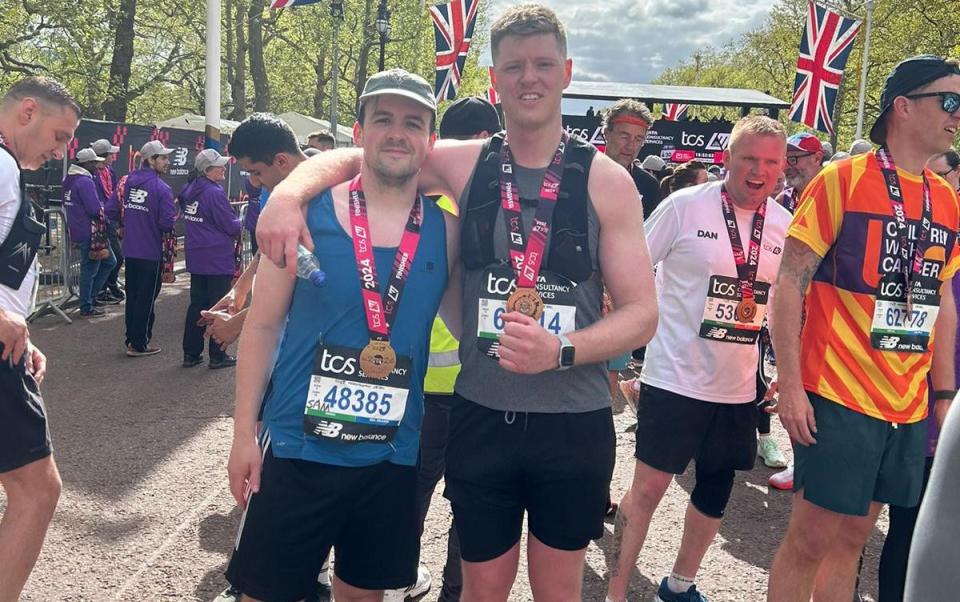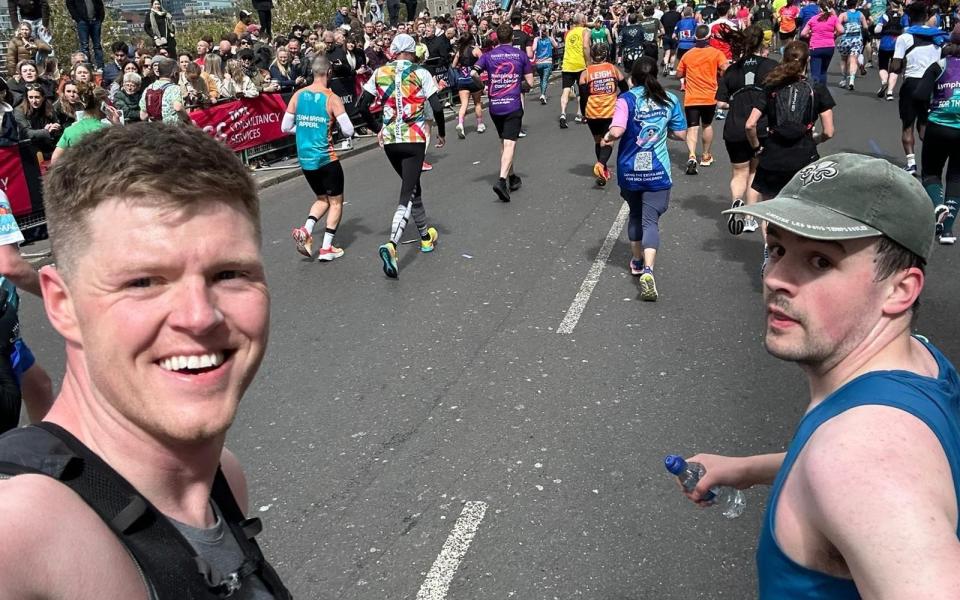‘After 26.2 long miles, I was barely able to walk – this was not the London Marathon I’d envisaged’

Before we go any further, a confession: this wasn’t the piece I had intended to write.
At the end of last year, when I first got confirmation that I had a place in the London Marathon, I harboured great hopes of smashing my previous personal best (3hrs 50mins) and making the 3hrs 30mins mark.
A strict training programme, a disciplined approach to nutrition, and a strict no-alcohol policy would be the key to this success, I told myself.
I envisioned crossing the finishing line in front of Buckingham Palace after running the race of my life, a medal placed around my neck, exhausted but content in the knowledge that I’d joined one of the sport’s exclusive (albeit not very elite) clubs.
Yet, this is not what happened. I may have ended yesterday’s race with a medal, but it came after 4hrs 31mins pounding the pavement – a whole 60 minutes slower than first hoped.
After 26.2 long miles, I stumbled across the finishing line in agony, my legs filled with lactic acid, barely able to walk, my shoulders curled over like a shrimp, and my right sock sodden with blood from mashed up toe nails.
I’d run the London Marathon twice before, in 2018 and 2019, when I was in my early 20s; the first took me roughly 4hrs 40mins; the second was almost an hour quicker.
This meant, early on Sunday morning, now 29, I was prepared – at least mentally – for what was to come.
But even this wasn’t enough to ease my suffering as, mile by mile, step by step, I entered deeper and deeper into the pain cave.
The fatigue kicked in after 10 miles or so (leaving me dreading what was to come) but it was as I plodded out from beneath the shadows of Canary Wharf’s skyscrapers – my left calf on the verge of popping – that I started to question my life decisions.

It’s here that the crowds are at their most animated: with their signs, flags, Haribo handouts, and occasional offering of a cold beer, it feels like you’ve got the whole world behind you, willing you forward, assuring you repeatedly that there really isn’t that far to go.
But even this wasn’t enough to boost my efforts on the home straight; the tank was empty, the spring gone from my step.
And yet, despite this, and despite missing out on my original goal, I felt no sense of disappointment as my race concluded at roughly 3.30pm yesterday afternoon, some several hours after Alexander Mutiso Munyao and Peres Jepchirchir claimed victory in the men and women’s elite races, respectively.
In truth, I always knew I was destined for a slow time.
This is largely because my strict training programme wasn’t so strict after all, my disciplined approach to nutrition was anything but, and the lure of a cold post-work beer ultimately proved too strong over the past 12 weeks.
Let me explain in more detail.
Five years ago, when I set my best time for a marathon, my training consisted of roughly three runs a week: one recovery run, one speed run, and one long run. That was a deliberate decision at the time to minimise overuse injuries that had plagued my very first attempt.
This time around, I thought it would make sense to adopt the same approach, not really taking into account that I didn’t have several years of running experience in my legs as I had had in 2019. (Throughout Covid, I neglected running, taking up cycling instead. Post-Covid, I neglected all sports entirely, having rediscovered the joy of pubs and fine dining.)
I was foolish to overlook the small five or six-mile runs that help add weekly mileage to the tank and prepare the legs for the longer weekend runs.
This meant my repeated attempts to get over 16 miles in training often fell flat, ending in dejection as I trudged to the nearest bus stop to head home early. In total, I managed just one 18-mile run before race day – nowhere near enough for a three-and-a-half-hour finish.
Then there was the issue of my ego. Midway through my training programme, frustrated that I was off-track, I started introducing quick segments to my longer runs as I’d read this could help quicken my overall pacing for race day.
Yet I didn’t have the fitness for this. Had I plodded along at a snail’s pace, I may have stood a better chance of getting over 18 miles. Instead, I ended up tiring myself out far too early into each long run.
I partly blame my Garmin for this. Yes, it’s an exceptionally weak excuse, but I’d never run with one before, preferring instead to map out my routes in advance and go off “instinct” and “feeling” to set my pacing.
Five years ago, it seemed to work. This time around, I couldn’t take my eyes off my wrist to check my pacing. Each glance brought with it the temptation to speed up – to 9.15 minutes per mile, then 9.0 minutes per mile, then 8.45 minutes per mile, and on and on it went.
Stupid, I know. I only have myself to blame. But when you’re so fixated on a specific time – one that would also have beaten my partner’s own personal best, a serious bragging right in our household – you find yourself doing whatever you can to make it.
Lastly – and, again, I appreciate this will elicit little sympathy – there was the “inconvenience” of a two-week holiday to Argentina just over a month before the race.

I should have been entering the peak of my training and fitness at this stage. But, my God: the steaks, the wine, the dulce de leche cookies. I fell from the wagon, and fell hard.
Do I regret it? Somewhat. Would I do it again? Most likely.
Taken together, it’s not hard to see why my final long run – what should have been 22-miles around Buenos Aires’ peaceful (and flat) nature reserve – was cut short after 14 miles.
As such, lining up at the beginning of the marathon yesterday morning, I knew what was likely in store for me.
But for all the pain and post-run aches, it was still worth it.
There are few days like it in London, when the whole capital comes together to cheer on random strangers and the fantastic causes they’re championing.
In my case, I ended up joining an old school friend who was running for Cancer Research UK in memory of his mum. I wouldn’t have been able to finish the race without him, and I know he was grateful to have me by his side, too.
Thousands of others ran yesterday’s race with their own stories, tales of adversity and heartbreak, and the support of loving families and friends behind them.
And regardless of timing, it’s an achievement in itself that they – and we – were able to take on this challenge and see it through to the end.
My fitness also greatly improved through my thrice weekly runs (even if this wasn’t enough for a 3.30 finish). Part of the original inspiration for signing up was to lose weight and keep me disciplined. Having lost several kilograms (I’m now 80kg), it was therefore a big success on this front.
So, what did I learn from my third marathon? Drop the ego. Don’t neglect the baby runs. And spring is a fantastic time to visit Argentina.
Sam’s London Marathon times
First attempt (2018): 4hrs 40mins
Second attempt (2019): 3hrs 50mins
Third attempt (2024): 4hrs 31mins
Average marathon times
Men: 4hrs 13 mins
Women: 4hrs 42 mins
Pacing needed for 3hr 30min race: 8 minutes per mile
Recommended
What to eat before, during and after a marathon

